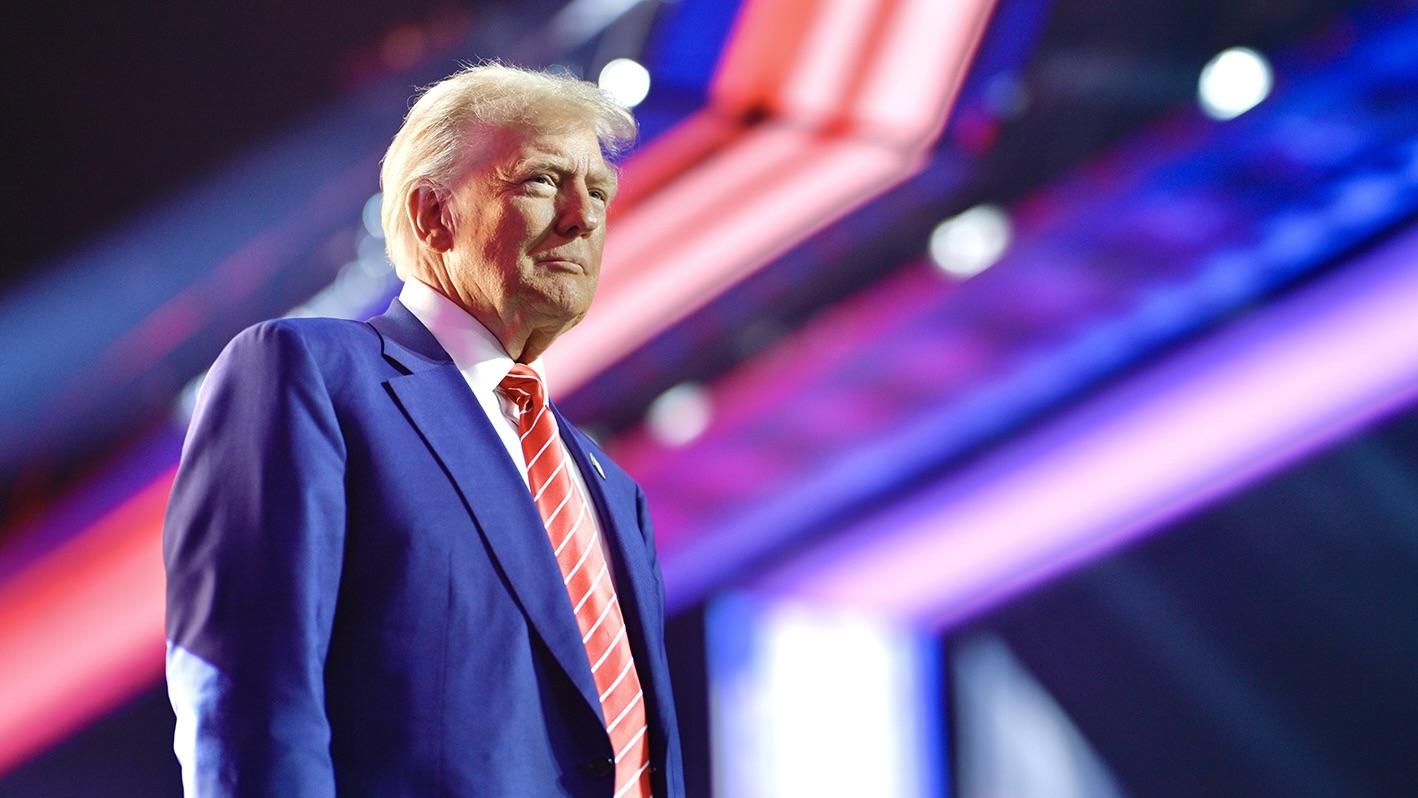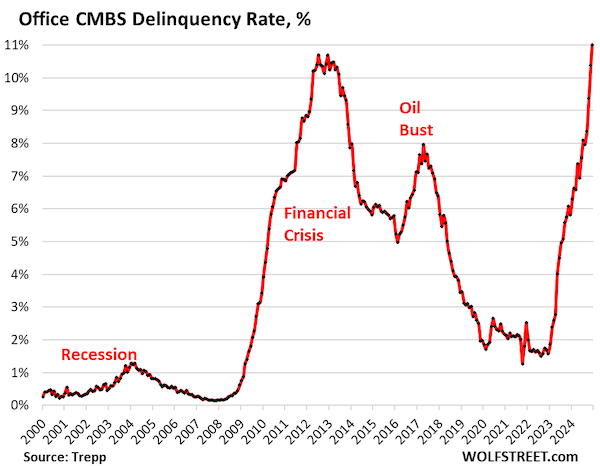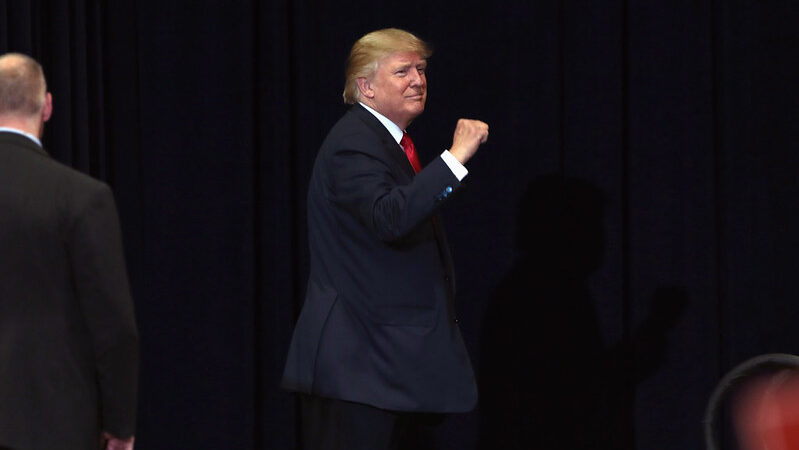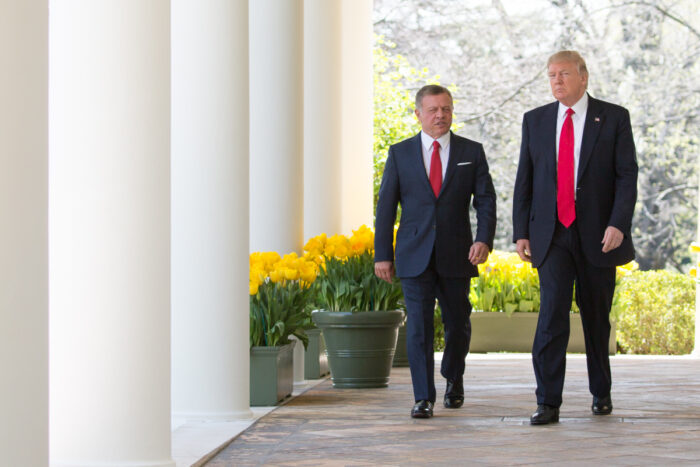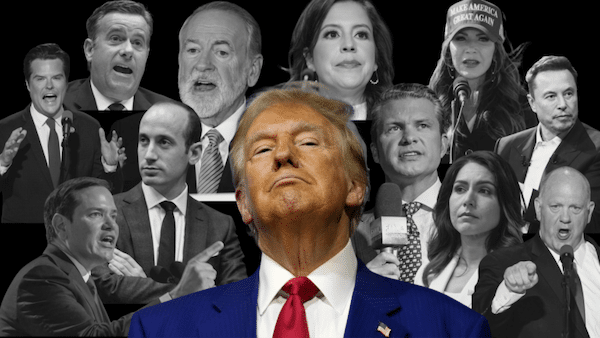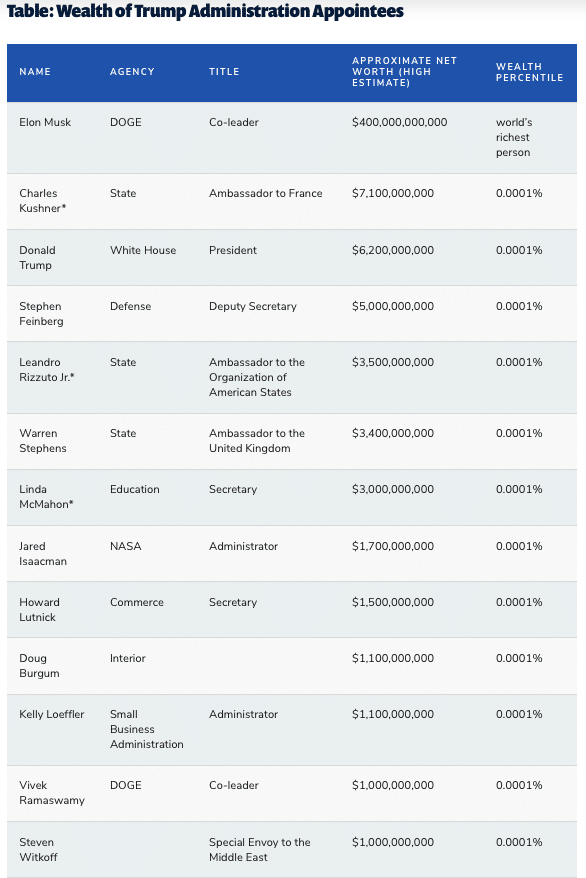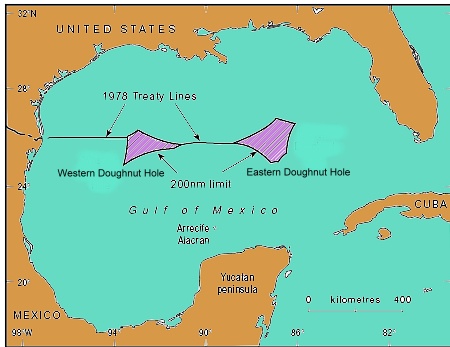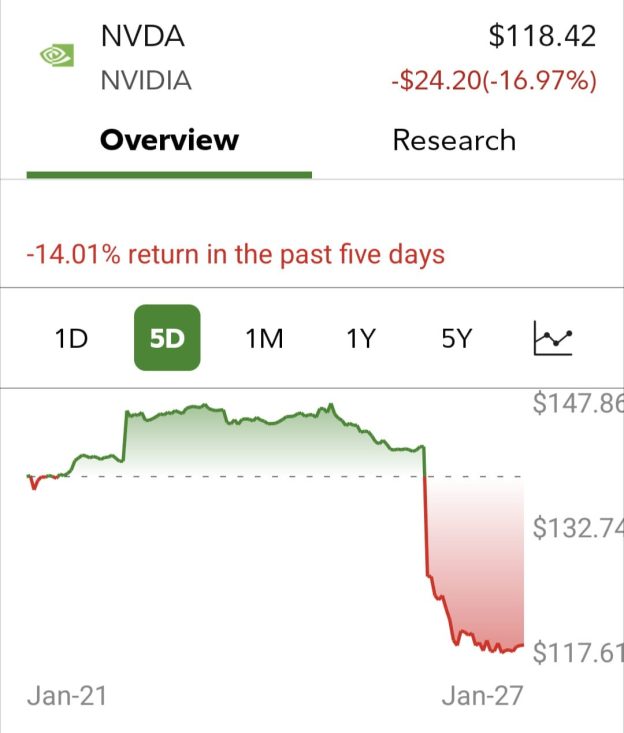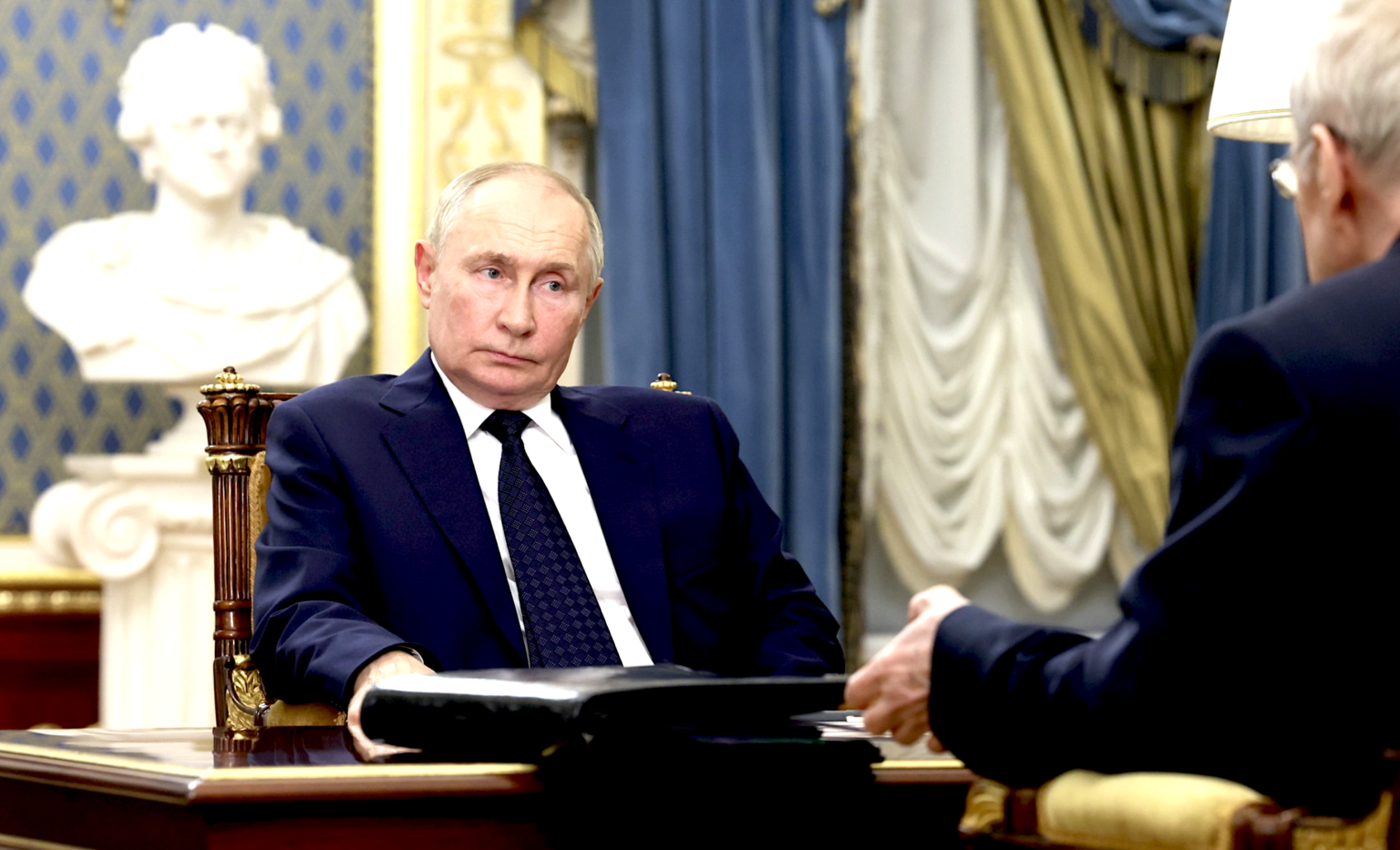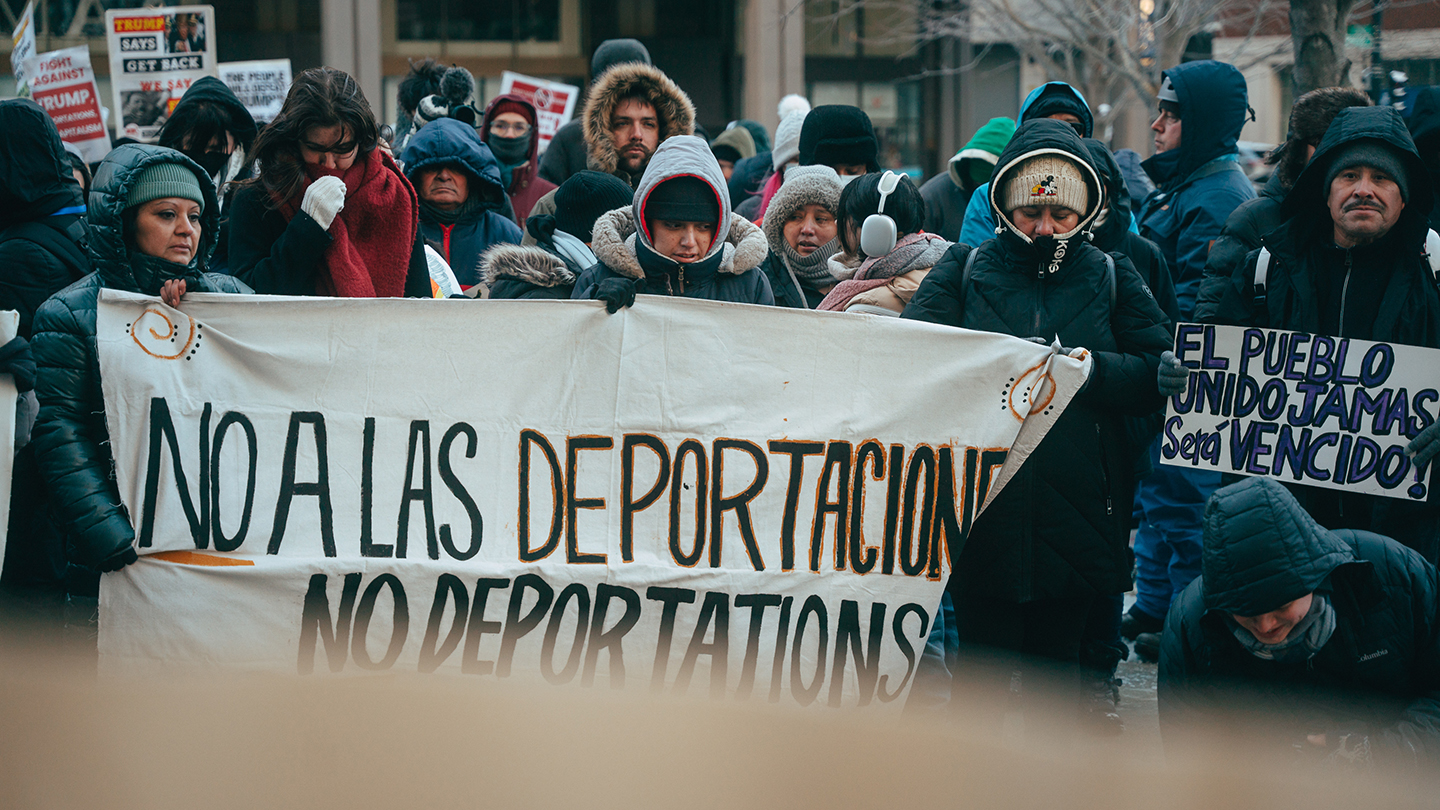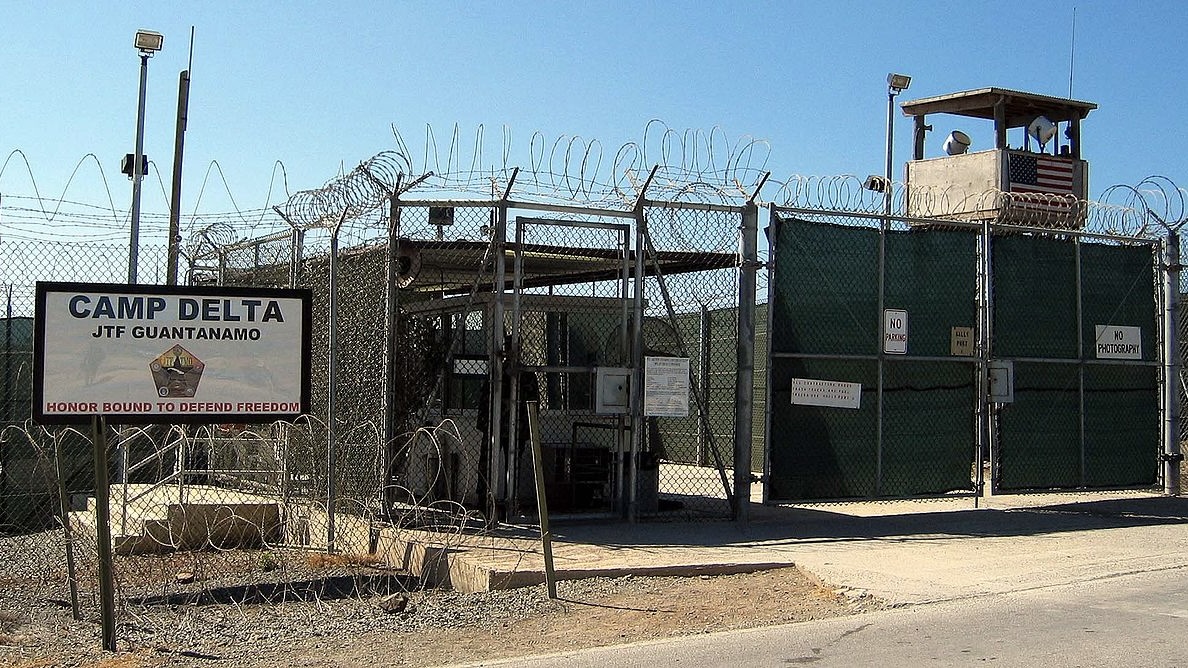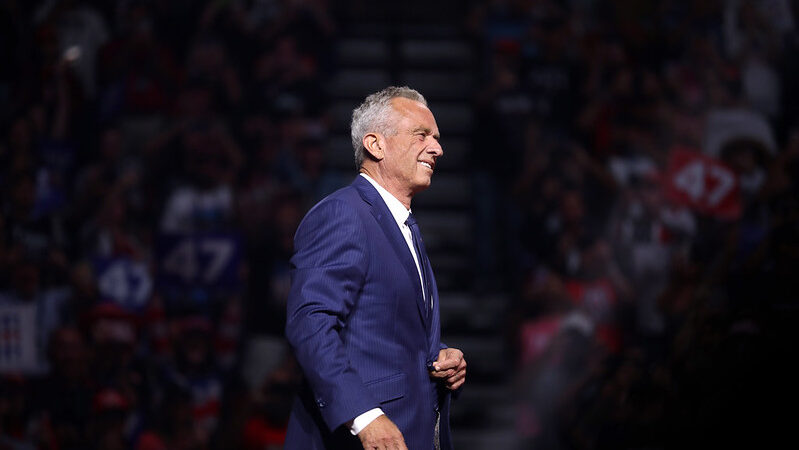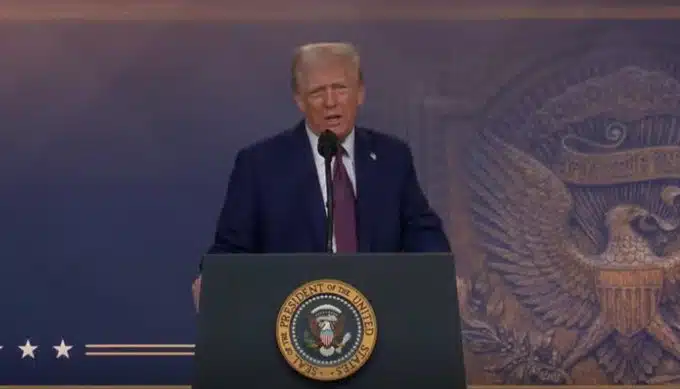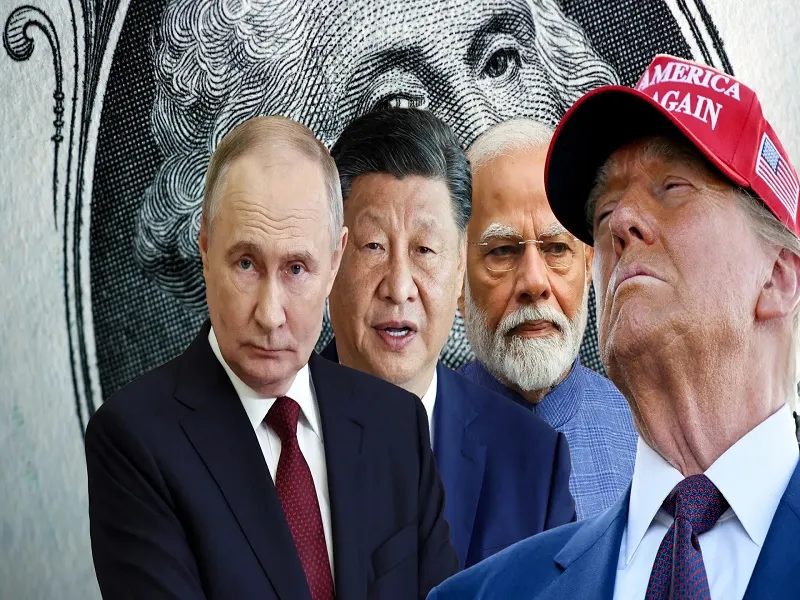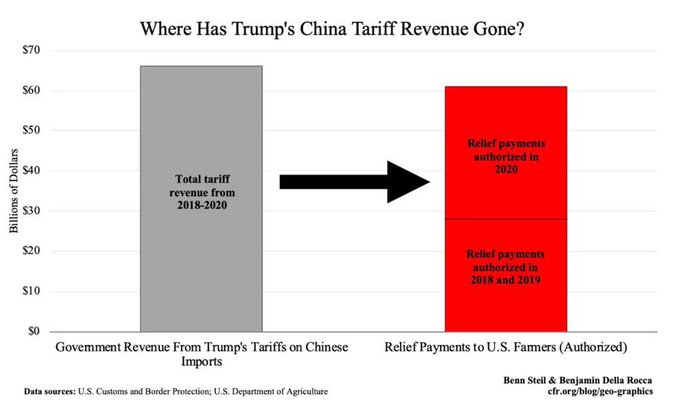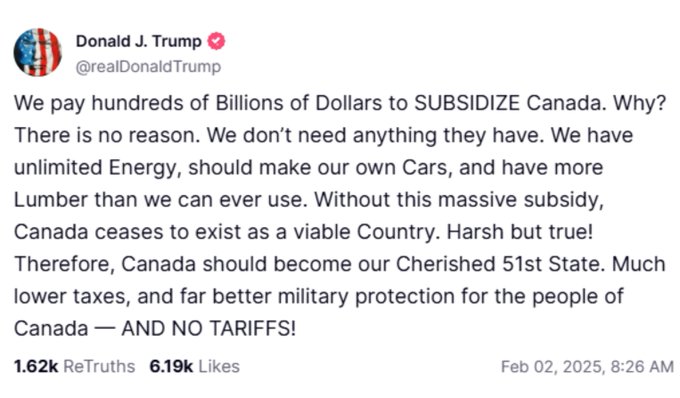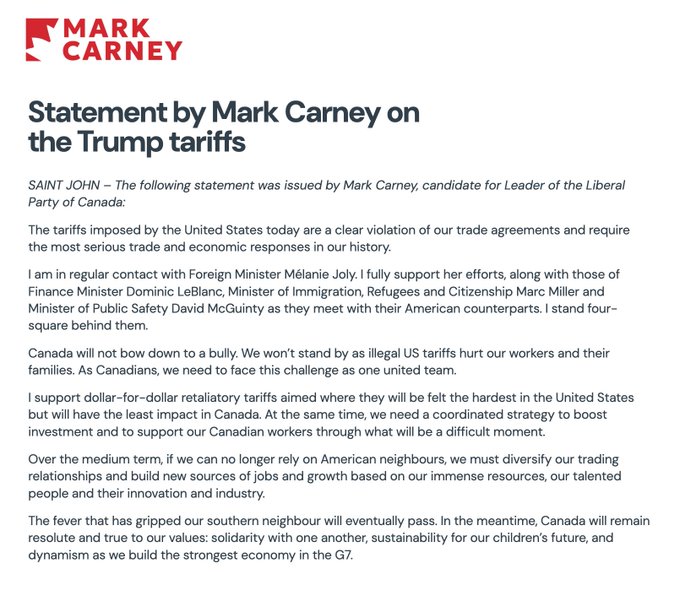Posted on January 25, 2025 by Yves Smith
Yves here. Of course, one looming question regarding efficiency is efficient for whom? If we look at a private sector example, lousy insurance claims processing is efficient by lowering costs (staffing levels) and pushing costs onto policy holders, with the actual main objective to reduce payouts rather than to achieve particular cost or throughput levels at the claim processing unit level.
Here, as with the successful push to get the inherently higher cost money-pit Uber widely accepted, the goals, despite being expressed as budgetary, are ideological, to further weaken government so it cannot interfere much with rule by oligarch.
And to raise a related issue, highly efficient systems are unstable. Increasing safety has costs and that is a major function governments provide, as do private insurers. Going naked is cheaper than buying coverage, unless/until you are hit by a bad outcome.
By Jennifer Selin, Associate Professor of Law, Arizona State University. Originally published at The Conversation
As President Donald Trump issued a slew of executive orders and directives on his first day of his second administration, he explained his actions by saying, “It’s all about common sense.”
For over a century, presidents have pursued initiatives to improve the efficiency and effectiveness of government, couching those efforts in language similar to Trump’s.
Many of these, like Trump’s Department of Government Efficiency, which he appointed billionaire Elon Musk to run, have been designed to capitalize on the expertise of people outside of government. The idea often cited as inspiration for these efforts: The private sector knows how to be efficient and nimble and strives for excellence; government doesn’t.
But government, and government service, is about providing something that the private sector can’t. And outsiders often don’t think about the accountability requirements that the laws and Constitution of the United States impose on government workers and agencies.
Congress, though, can help address these problems and check inappropriate proposals. It can also stand in the way of reform.
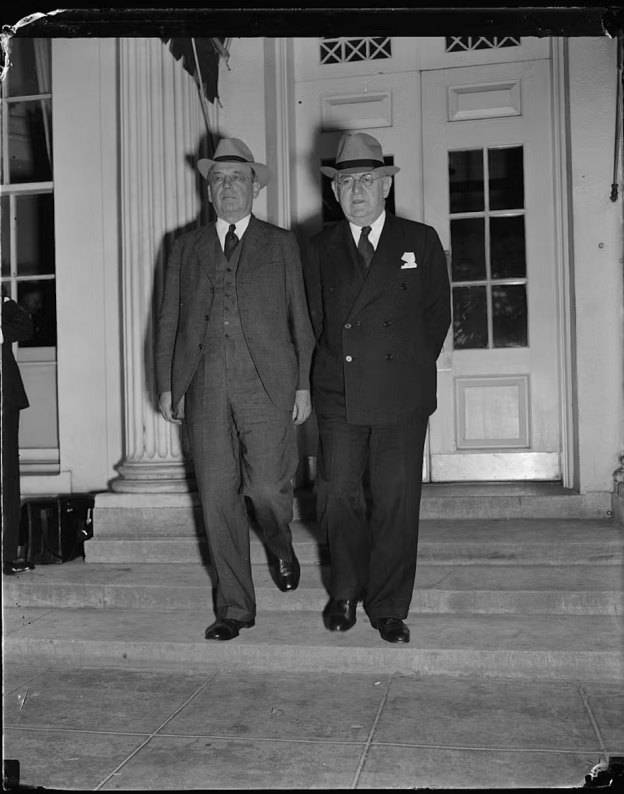
Charles E. Merriam, left, and Louis Brownlow, members of the President’s Reorganization Committee, leave the White House after discussing government reorganization with President Franklin D. Roosevelt on Sept. 23, 1938. Harris & Ewing, photographer, Library of Congress
Proposing Reform Is Nothing New
Perhaps the most famous group to work with a president on improving government was President Franklin D. Roosevelt’s Committee on Administrative Management, established in 1936.
That group, commonly referred to as the Brownlow Committee, noted that while critics predicted Roosevelt would bring “decay, destruction, and death of democracy,” the executive branch – and the president who sat atop it – was one of the “very greatest” contributions to modern democracy.
The committee argued that the president was unable to do his job because the executive branch was badly organized, federal employees lacked skills and character, and the budget process needed reform. So it proposed a series of changes designed to increase presidential power over government to enhance performance. Congress went along with some of these proposals, giving the president more staff and authority to reorganize the executive branch.
Since then, almost every president has put together similar recommendations. For example, Presidents Harry S. Truman and Dwight D. Eisenhower appointed former President Herbert Hoover to lead advisory commissions designed to recommend changes to the federal government. President Jimmy Carter launched a series of government improvement projects, and President George W. Bush even created scorecards to rank agencies according to their performance.
In his first term, Trump issued a mandate for reform to reorganize government for the 21st century.
This time around, Trump has taken executive actions to freeze government hiring, create a new entity to promote government efficiency, and give him the ability to fire high-ranking administrators who influence policy.
Most presidential proposals generally fail to come to fruition. But they often spark conversations in Congress and the media about executive power, the effectiveness of federal programs, and what government can do better.
Most Presidents Have Tried the Same Thing
Historically, most presidents and their advisers – and indeed most scholars – have agreed that government bureaucracy is not designed in ways that promote efficiency. But that is intentional: Stanford political scientist Terry Moe has written that “American public bureaucracy is not designed to be effective. The bureaucracy arises out of politics, and its design reflects the interests, strategies, and compromises of those who exercise political power.”
A common presidential response to this practical reality is to propose government changes that make it look more like the private sector. In 1982, President Ronald Reagan brought together 161 corporate executives overseen by industrialist J. Peter Grace to make recommendations to eliminate government waste and inefficiency, based on their experiences leading successful corporations.
In 1993, President Bill Clinton authorized Vice President Al Gore to launch an effort to reinvent the federal government into one that worked better and cost less.
The Clinton administration created teams in every major federal agency, modeled after the private sector’s efficiency standards, to move government “From Red Tape to Results,” as the title of the administration’s plan said.
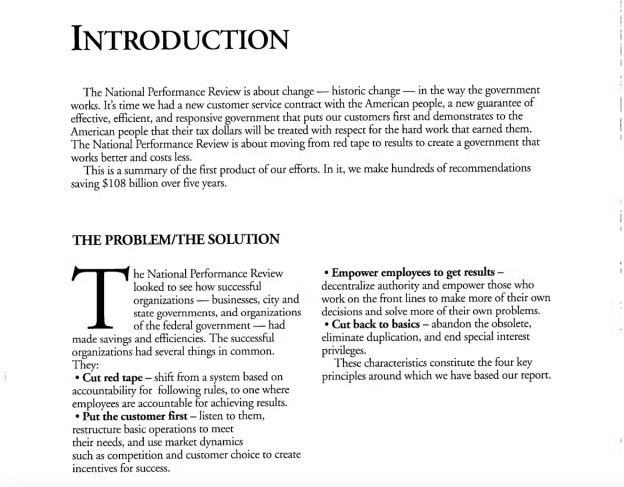
An introductory page from the 1993 National Performance Review executive summary, commissioned by the Clinton administration. CIA.gov
Presidential attempts to make government look and work more like people think the private sector works often include adjustments to the terms of federal employment to reward employees who excel at their jobs.
In 1905, for example, President Theodore Roosevelt established a Committee on Department Methods to examine how the federal government could recruit and retain highly qualified employees. One hundred years later, federal agencies still experienced challenges](https://www.gao.gov/assets/gao-03-2.pdf) related to hiring and retaining people who could effectively achieve agency missions.
So Why Haven’t These Plans Worked?
At least the past five presidents have faced problems in making long-term changes to government.
In part, this is because government reorganizations and operational reforms like those contemplated by Trump require Congress to make adjustments to the laws of the United States, or at least give the president and federal agencies the money required to invest in changes.
Consider, for example, presidential proposals to invest in new technologies, which are a large part of Trump and Musk’s plans to improve government efficiency. Since at least 1910, when President William Howard Taft established a Commission on Economy and Efficiency to address the “unnecessarily complicated and expensive” way the federal government handled and distributed government documents, presidents have recommended centralizing authority to mandate federal agencies’ use of new technologies to make government more efficient.
But transforming government through technology requires money, people and time. Presidential plans for government-wide change are contingent upon the degree to which federal agencies can successfully implement them.
To sidestep these problems, some presidents have proposed that the government work with the private sector. For example, Trump announced a joint venture with technology companies to invest in the government’s artificial intelligence infrastructure.
Yet as I have found in my previous research, government investment in new technology first requires an assessment of agencies’ current technological skills and the impact technology will have on agency functions, including those related to governmental transparency, accountability and constitutional due process. It’s not enough to go out and buy software that tech giants recommend agencies acquire.
The things that government agencies do, such as regulating the economy, promoting national security and protecting the environment, are incredibly complicated. It’s often hard to see their impact right away.
Recognizing this, Congress has designed a complex set of laws to prevent political interference with federal employees, who tend to look at problems long term. For example, as I have found in my work with Paul Verkuil, former chairman of the Administrative Conference of the United States, Congress intentionally writes laws that require certain government positions to be held by experts who can work in their jobs without worrying about politics.
Congress also writes the laws the federal employees administer, oversees federal programs and decides how much money to appropriate to those programs each year.
So by design, anything labeled a “presidential commission on modernizing/fixing/refocusing government” tells only part of the story and sets out an impossible task. The president can’t make it happen alone. Nor can Elon Musk.
https://www.nakedcapitalism.com/2025/01 ... n-and.html
How Much Will Trump’s Bark Exceed His Bite? Doubts About Whether Disruptive Federal Hiring and Spending Pauses Will Produce Lasting Changes
Posted on January 24, 2025 by Yves Smith
Trump is adept at using his willingness to be wildly inconsistent to destabilize opponents. But he is unduly fond of using blunt instruments like tariffs that he can impose unilaterally, with insufficient consideration of whether they will work all that well, let alone what bad unintended effects they might generate.
What Trump has done so far can be likened to punching through enemy lines with tank columns at several vulnerable spots. The initial assault has breached established positions. But what comes next? Does the aggressor have enough logistical support, and infantry and air power to exploit the breaches, press into the enemy terrain, take and hold ground, ultimately seizing swathes of territory?1 Or will the tanks rattle around in the enemy’s rear, inflicting damage in a contained area before they run out of gas and ammo?
It’s far too early too tell, but the safest bet is that Trump will wind up somewhere between these two extreme possibilities. We’ll get some early indications via the caliber of Team Trump responses to predictable challenges. For instance, the Trump executive order revoking birthright citizenship ran into a buzzsaw of lawsuits, including one from 24 state attorneys general. That suit produced an injunction and tart criticism from a Reagan-appointed Federal judge. But the matter will be litigated, which is sure to include appeals. Trump’s executive order contends that it is consistent with a carveout in the 14th Amendment:
But the Fourteenth Amendment has never been interpreted to extend citizenship universally to everyone born within the United States. The Fourteenth Amendment has always excluded from birthright citizenship persons who were born in the United States but not “subject to the jurisdiction thereof.”
Some readers have pointed out that conventional accounts of the precedents are misleading and so Trump losing is far from a given.2 We will get an idea of the caliber of Trump’s legal thinking via its court filings, which will give more insight both into how well prepared his team is as well as the depth of his bench.
On another front, ICE started immigration raids yesterday, a day behind the promised schedule, starting with New Jersey and Indiana. Again the Trump team pushed beyond legal boundaries, engaging what Newark’s mayor said were warrantless searches that resulted in citizens, including a a US veteran, being detained. Recall that everyone on US soil has due process rights.
On another front, Congresscritters regard Trump’s halt of the Supreme-Court-mandated sale or closure of TikTok and his joint venture scheming to be flouting the ruling, but as I read the account of the pearl-clutching in Politico, no one appears willing to Do Something about it.
But Trump’s actions within the Federal bureaucracy at the moment are causing the most stir. Later in this post, we reproduce a KFF Health News article which is comparatively chill about the impact of the Trump executive orders on the health care front, pointing out that most need follow through, and in many cases legislation, before they have any impact.
But the lead story in the Wall Street Journal tonight describes how widespread spending and activity freezes are creating chaos, including with programs that are beneficial to Trump constituencies and/or not on any particular Trump hit list. Remember that refusing to spend appropriated funds would be subject to legal challenge, while holding up spending to conduct a review as to whether how it has been done is compliant or inefficient is defensible.
Again, as with tariffs, Trump is wielding yet another blunt instrument, with at least some of the motivation a dominance display. But the knock-on effects are large. If you’ve ever worked on a large project in a bureaucracy, or between companies, you likely have seen that missing a deadline, having a key decision postponed, or a “shit happens” event like a big storm forcing the rescheduling of a critical planning meeting, you’ve probably seen how a single consequential delay often pushes out the completion date disproportionately. And what we see here is not a single delay but almost total freezes, with the restart (if any) time frames uncertain. And since this includes vendor payments, some businesses like research labs could even close if the wait is too long.
From Swaths of U.S. Government Grind to a Halt After Trump Shock Therapy in the Journal:
The Transportation Department temporarily shut down a computer system for road projects. Health agencies stopped virtually all external communications in a directive that risked silencing timely updates on infectious diseases. A hiring freeze left agencies wondering how parts of the government could adapt to new demands. Confusion loomed over how agencies should disburse funds allocated by the previous administration…
New leadership at the Department of Health and Human Services halted all external communications from the health agencies through Feb. 1. Food and Drug Administration employees scrambled to clarify that they could still issue critical safety alerts, while scientists said that their grant-review meetings had been canceled, potentially endangering funding for their health research.
The communications pause caught the attention of Congress, with Sen. Amy Klobuchar (D., Minn.) urging Agriculture Department nominee Brooke Rollins to ask why the Centers for Disease Control and Prevention’s messages to farmers on bird flu had been halted. “We’re concerned,” Klobuchar said.
Some of these communication pauses were due, no joke, to language policing, as in to change “pregnant persons” back to “pregnant women”. But the overkill is producing The Gang That Couldn’t Shoot Straight results.
Later in the same article:
Meetings to review potential NIH grants—the lifeblood of American science—were canceled during the communications stoppage…
Some federal workplaces rescinded job offers to comply with a hiring freeze issued from the White House earlier this week. That included the Department of Veterans Affairs’ hospitals and clinics, according to Jacqueline Simon of the American Federation of Government Employees labor union. The White House also directed two of its offices to come up with a plan to shrink the federal workforce….
Most agencies were under a hiring freeze that could last up to 90 days, but it could run longer at the Internal Revenue Service, even as the agency enters tax season and the period in which it normally hires many seasonal employees. Rather than the standard 90 days, the Trump order that freezes hiring said that the Treasury Department must sign off before the IRS can hire again. The agency canceled a Thursday webinar to give résumé tips to potential applicants.
So tax refunds will be issued even later for 2024. A last set of tidbits:
Agencies were also scrambling to understand a Trump executive order that instituted an immediate pause on the distribution of funds from former President Joe Biden’s 2021 infrastructure law and his 2022 climate law….
The order told agencies to review cash disbursements and submit reports on their status within 90 days. Many of those funds had been promised to companies through loan contracts, which are legally binding, experts said.
The order set off a wave of confusion about which funds needed to be halted.
A story from STAT describes the potential damage from blind application of the Trump DEI rollback:
The deletion of references to DEI issues appears to be playing out across government sites….The Trump administration even shut down the White House’s Spanish-language page.
But the scrubbing of clinical trial-related pages is notable because of how it could affect the ways researchers both inside and outside government, as well as companies, test drugs and medical devices. Under the Biden administration, the FDA had urged industry to enroll more people of color and women in trials, and released draft guidance in June 2024 about how it should do so. It is unclear whether that guidance will ever be finalized, or whether the webpage removals mean the Trump administration intends to abandon efforts to diversify clinical trials.
Scientists have focused on the issue of diversity in clinical studies both because lacking a diverse population can lead to skepticism from patients who could be helped by medicines and because some drugs do work differently in people of different backgrounds.
On a more cheerful note, KFF Health News looked at key Trump health care executive orders, and found that by themselves, they amounted more to being statements of intent rather than initiatives. So it’s far from clear how much will be translated into actual programs.
By Julie Appleby and Stephanie Armour. Originally published at KFF Health News
President Donald Trump’s early actions on health care signal his likely intention to wipe away some Biden-era programs to lower drug costs and expand coverage under public insurance programs.
The orders he issued soon after reentering the White House have policymakers, health care executives, and patient advocates trying to read the tea leaves to determine what’s to come. The directives, while less expansive than orders he issued at the beginning of his first term, provide a possible road map that health researchers say could increase the number of uninsured Americans and weaken safety-net protections for low-income people.
However, Trump’s initial orders will have little immediate impact. His administration will have to take further regulatory steps to fully reverse Biden’s policies, and the actions left unclear the direction the new president aims to steer the U.S. health care system.
“Everyone is looking for signals on what Trump might do on a host of health issues. On the early EOs, Trump doesn’t show his cards,” said Larry Levitt, executive vice president for health policy at KFF, the health policy research, polling, and news organization that includes KFF Health News.
A flurry of executive orders and other actions Trump issued on his first day back in office included rescinding directives by his predecessor, former President Joe Biden, that had promoted lowering drug costs and expanding coverage under the Affordable Care Act and Medicaid.
Executive orders “as a general matter are nothing more than gussied up internal memoranda saying, ‘Hey, agency, could you do something?’” said Nicholas Bagley, a law professor at the University of Michigan. “There may be reason to be concerned, but it’s down the line.”
That’s because making changes to established law like the ACA or programs like Medicaid generally requires new rulemaking or congressional action, either of which could take months. Trump has yet to win Senate confirmation for any of his picks to lead federal health agencies, including Robert F. Kennedy Jr., the anti-vaccine activist and former Democratic presidential candidate he has nominated the lead the Department of Health and Human Services. On Monday, he appointed Dorothy Fink, a physician who directs the HHS Office on Women’s Health, as acting secretary for the department.
“We’re getting rid of all of the cancer — I call it cancer — the cancer caused by the Biden administration,” Trump told reporters as he signed some of the executive orders in the Oval Office on Jan. 20. His order rescinding more than 70 Biden directives, including some of the former president’s health policies, said that “the previous administration has embedded deeply unpopular, inflationary, illegal, and radical practices within every office of the Federal Government.”
During Biden’s term, his administration did implement changes consistent with his health orders, including lengthening the enrollment period for the ACA, increasing funding for groups that help people enroll, and supporting the Inflation Reduction Act, which boosted subsidies to help people buy coverage. After falling during the Trump administration, enrollment in ACA plans soared under Biden, hitting record highs each year. More than 24 million people are enrolled in ACA plans for 2025.
The drug order Trump rescinded called on the Centers for Medicare & Medicaid Services to consider tests to lower drug costs. The agency came up with some ideas, such as setting a flat $2 copay for some generic drugs in Medicare, the health program for people 65 and older, and having states try to get better prices by banding together to buy certain expensive cell and gene therapies.
That Trump included the Biden drug order among his revocations may indicate he expects to do less on drug pricingthis term or even roll back drug price negotiation in Medicare. Or it may have been slipped in as simply one more Biden order to erase.
The White House did not respond to a request for comment.
Biden’s experiments in lowering drug prices didn’t fully get off the ground, said Joseph Antos of the American Enterprise Institute, a right-leaning research group. Antos said he’s a bit puzzled by Trump’s executive order ending the pilot programs, given that he has backed the idea of tying drug costs in the U.S. to lower prices paid by other nations.
“As you know, Trump is a big fan of that,” Antos said. “Lowering drug prices is an easy thing for people to identify with.”
In other moves, Trump also rescinded Biden orders on racial and gender equity and issued an order asserting that there are only two sexes, male and female. HHS under the Biden administration supported gender-affirming health care for transgender people and provided guidance on civil rights protections for transgender youths. Trump’s missive on gender has intensified concerns within the LGBTQ+ community that he will seek to restrict such care.
“The administration has forecast that it will fail to protect and will seek to discriminate against transgender people and anyone else it considers an ‘other,’” said Omar Gonzalez-Pagan, senior counsel and health care strategist at Lambda Legal, a civil rights advocacy group. “We stand ready to respond to the administration’s discriminatory acts, as we have previously done to much success, and to defend the ability of transgender people to access the care that they need, including through Medicaid and Medicare.”
Trump also halted new regulations that were under development until they are reviewed by the new administration. He could abandon some proposals that were yet to be finalized by the Biden administration, including expanded coverage of anti-obesity medications through Medicare and Medicaid and a rule that would limit nicotine levels in tobacco products, Katie Keith, a Georgetown University professor who was deputy director of the White House Gender Policy Council under Biden, wrote in an article for Health Affairs Forefront.
“Interestingly, he did not disturb President Biden’s three executive orders and a presidential memorandum on reproductive health care,” she wrote.
However, Trump instructed top brass in his administration to look for additional orders or memorandums to rescind. (He revoked the Biden order that created the Gender Policy Council.)
Democrats criticized Trump’s health actions. A spokesman for the Democratic National Committee, Alex Floyd, said in a statement that “Trump is again proving that he lied to the American people and doesn’t care about lowering costs — only what’s best for himself and his ultra-rich friends.”
Trump’s decision to end a Biden-era executive order aimed at improving the ACA and Medicaid probably portends coming cuts and changes to both programs, some policy experts say. His administration previously opened the door to work requirements in Medicaid — the federal-state program for low-income adults, children, and people with disabilities — and previously issued guidance enabling states to cap federal Medicaid funding. Medicaid and the related Children’s Health Insurance Program cover more than 79 million people.
“Medicaid will be a focus because it’s become so sprawling,” said Chris Pope, a senior fellow at the Manhattan Institute, a conservative policy group. “It’s grown after the pandemic. Provisions have expanded, such as using social determinants of health.”
The administration may reevaluate steps taken by the Biden administration to allow Medicaid to pay for everyday expenses some states have argued affect its beneficiaries’ health, including air conditioners, meals, and housing.
One of Trump’s directives orders agencies to deliver emergency price relief and “eliminate unnecessary administrative expenses and rent-seeking practices that increase healthcare costs.” (Rent-seeking is an economic concept describing efforts to exploit the political system for financial gain without creating other benefits for society.)
“It is not clear what this refers to, and it will be interesting to see how agencies respond,” Keith wrote in her Health Affairs article.
Policy experts like Edwin Park at Georgetown University have also noted that, separately, Republicans are working on budget proposals that could lead to large cuts in Medicaid funding, in part to pay for tax cuts.
Sarah Lueck, vice president for health policy at the Center on Budget and Policy Priorities, a left-leaning research group, also pointed to Congress: “On one hand, what we see coming from the executive orders by Trump is important because it shows us the direction they are going with policy changes. But the other track is that on the Hill, there are active conversations about what goes into budget legislation. They are considering some pretty huge cuts to Medicaid.”
_____
1 If readers see this analogy as apt, it means that Trump is actually waging a traditional war, albeit on an unusually intense scale, as opposed to something more Clausewitzian, designed to erode the enemy’s capacity to fight and eventually, his will to endure. But I think the latter could work only in the US with some sort of actual revolution. The fact that Trump is still very much using the existing bureaucratic apparatus means its own procedures, governance, and legal oversight can be used to thwart or impede him.
2 For instance, from Peter Steckel:
The EO ending birthright citizenship is a trap if I have ever seen one. Putting on my legal hat here, the issue of birth right citizenship has NEVER been decided by the Supreme Court. The two previous decisions refer to the idea of birth right citizenship in what is referred to as “dicta”, or verbiage around the issue being decided by the Supreme Court that is not necessary to decide the instant legal matter under review. Novices often mistake “dicta” as part of a Court ruling – in a strict sense it is not – when in reality it is the “legalese” version of “uhhhhhhhhh” before a thought is voiced…
The first SC decision to deal with this issue came about in U.S. v. Wong Kim Ark, in which the Court ruled that a child born on US soil (and the child of legal Chinese immigrants) could not be excluded from returning to the US under the Chinese Exclusion Act because he was “born of the soil.” What folks don’t appreciate is the legal immigrants portion of the ruling. It was extended, via dicta, to the children of non-legal aliens in the late 1960s.
This matter will be contentious but given the Court’s make up it will not be the slam dunk the left believes…
https://www.nakedcapitalism.com/2025/01 ... anges.html
******
Trump Raises Heat on Russia with Belligerent New Threats
Simplicius
Jan 24, 2025
In the last report we had the first inklings of Trump’s now-revealed approach to “ending the Ukraine war”, but now he has finally clarified it in full in a series of new statements, which included first and foremost this Tweet:
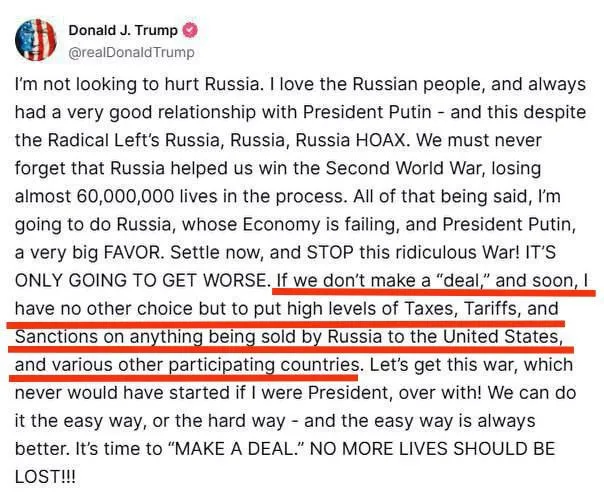
There are many things to be said here, but first let’s lay out all the statements on the table to see them as a whole. Here Trump begins to get even more belligerent and threatening than the post above—he very seriously threatens Russia with all kinds of “massive” taxes, tariffs, and sanctions if they don’t end the war “immediately”: (Video at link.)
So the big question becomes: how does Trump intend to put such devastating economic pressure on Russia, exactly? He mentions tariffs and taxes on imports, but this is almost an intentional joke: Russia and the US have virtually no trade turnover whatsoever; there is very little of any consequence from Russia that Trump could tax or tariff. The few things there are, like Uranium, are critical to the US which the US can’t get from anywhere else in the same quantity and timelines, and thus would be shooting himself in the foot.
Regarding Trump's threats...
Russian -US trade turnover is miniscule since 2021...
At the end of June last year, the volume of exports of Russian goods to the USA fell to the lowest level since 1996 - only 186.7 million dollars.
According to the Federal Customs Service, the United States was not even included in the top 10 largest trading partners of Russia for the period January-October 2024.
China is in first place with a share of 33.8%, and Uzbekistan on the tenth with 1.4%.
Trump announced possible sanctions on those countries that continue to buy products from Russia.
It's hard to imagine that the US will be able to get Beijing to stop buying Russian oil and gas.
So: as per the above, we know Trump is either lazily deluded, or is smarter than we think and is throwing an intentional deflection dart for his enemies. The real mechanism by which Trump aims to bring Russia to its knees is outlined below in two new statements stitched together in this video: (Video at link.)
Firstly, an important point must be made: Trump is extremely condescending to Saudi Arabia in the first statement above. Not only does he narcissistically remark that they should have already preemptively lowered oil prices as a kind of genuflection toward his new ascension to power, but then even outright blames the Saudis for starting the Ukraine war—a pretty outrageously extraneous remark. How exactly do you demand various tithes and tributes from a country to the tune of a trillion dollars, all while belittling them?
Needless to say, this alone marks a not-so-optimistic start to Trump’s war-ending plan. Trump appears to be under the impression that he’s still ruling in a previous bygone era—but times have passed him by, other countries are no longer as beholden nor fearful of the US and its big braggadocio threats. Putin has since developed closer ties to the Saudis and it seems hard to imagine they would skip and jump at Trump’s beck and call so easily all to spite Russia, with whom they now have good relations, highlighted by Saudi Arabia’s recent inclusion into the BRICS fold. 1
The way Trump has roared onto the scene, demeaning and bullying every country left and right, leaves one to ponder how truly effective his tactic will be in this new world. Denmark, Panama, and Mexico, for instance, have already rebuffed his wild threats, although some reports now claim Denmark is internally in turmoil politically vis-a-vis Greenland.
All in all, it’s still questionable what results Trump’s extremely grating and disrespectful approach will yield, and one surmises that the general concensus of countries treated thusly by Trump will reveal the overall state of the world and direction things will take in the short to medium term. If Trump’s now ‘mythic’-level stature is enough to push countries around all across the globe, it will denote a new muscular American era of global hegemony. But if countries resist, and there begins to be a kind of herd mentality courage that develops, with each subsequent country inheriting boldness from the previous one which demonstrated resistance, then Trump’s new American century may fall flat and be exposed as nothing more than a cheap machismo PR campaign; that of course would subsequently bode very poorly for Ukraine.
But let’s just say Trump’s plan to hit Russia on oil and gas works to an extent, whether through OPEC price reduction or the combination of that and a renewed targeting of Russia’s oil tanker ‘shadow fleet’, would this really “instantly end the war” in one day as Trump claims?
Firstly: even if Russia lost vast amounts of oil revenue, how could this possibly end its war effort “instantly”? Russia has one of the highest foreign exchange reserves in the world, not to mention various materials and commodities. Even such a hit as envisioned by Trump could not slow Russia’s war machine for quite a long time. But even that proposition is a big “if”.
Last time I reported that according to Bloomberg Russia’s revenues—which include mostly non oil and gas—have surged to record levels:
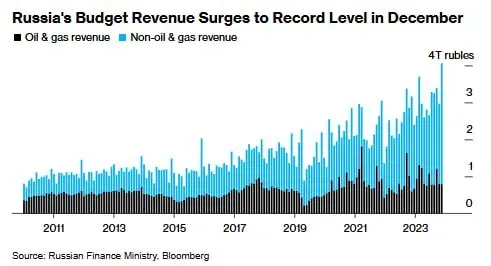
https://archive.ph/H0pSX
Total revenue in December reached more than 4 trillion rubles ($40 billion), up by 28% compared with the same month of the previous year, according to Bloomberg calculations based on Finance Ministry data published late Tuesday. That’s the highest level recorded in ministry data that starts from January 2011.
From the article, read the underlined very carefully:
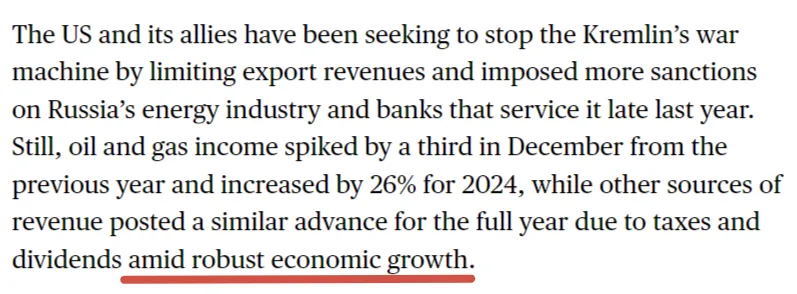
Bloomberg admits Russia has such high-flying economic growth that revenues are soaring even without counting oil.
“The volume of non-oil and gas revenues in 2024 significantly exceeded estimates in the 2025-2027 budget law, including from the largest tax sources,” the Finance Ministry said in a statement.
That’s not to mention the Ruble has been steadily rising against the USD again, now at 98 after spending weeks at around 102-103.
Kellogg, by the way, also echoed Trump’s plan in a new interview:
"Russia makes billions of dollars from oil sales. What if the price dropped to $45 a barrel?" Kellogg said.
So: what exactly is Trump talking about? Russia is quite well shielded against any possible sanctions he could dream up. So that leaves the only possible question: what is Trump prepared to do if and when his “plan” utterly flops?
This is the big question—will Trump’s ego lead him to turning Ukraine into his Vietnam, as Bannon sharply warned about days ago? Could Trump go “all out” and try to scare Russia by supplying Ukraine with everything, including moving past Biden’s old red lines and allowing Ukraine total deep strike authority into Russia, particularly with a slew of new weapons systems like JASSMs? Needless to say, such an action would gravely damage Trump’s “peace maker” hopes, nor would it ultimately have any real effect other than merely making Russia more angry.
Trump wanted to pull 20,000 troops from Europe—so it makes little sense that he’d do a 180 reversal and then commit major forces to Ukraine as a last ditch threat. As such, it seems Trump has few real options, and the war will likely continue being prosecuted under Russia’s timeline. Russian Duma member under Putin’s United Russia party Elena Panina said precisely this: (Video at link.)
Listen to what she says at the end:
“Now our task is to calmly move forward, occupy territory, liberate further, not yield to any provocations or blackmail, and understand that today we are in a stronger position than we were even three years ago.”
But I had mentioned in the opening that Trump’s threats seemed so almost unbelievably misguided that they could be perhaps read as deliberate misdirection rather than serious plans. Is this a possibility? Could Trump perhaps be merely going through the motions of what he’s “expected” to say by allies and the deep state in order to throw them off the scent, when in reality his real plan is to subversively cut off Ukraine and bleed it dry until capitulation? This would be a more conspiratorial “Q-Anon” level reading, but perhaps it’s possible, though the chance is likely low.
After all, a much more underratedly keen Trump would know not to show his hand too early before more of the deep state establishment was cleansed. As such, a plausible plan would be to “carry on the status quo” so as not to arouse too much suspicion at first, in the opening stanza of his administration, but then as his power is secured, begin progressively switching to a more anti-establishment position on Ukraine.
A new WSJ piece agrees that Russia is not afraid of Trump’s threats, claiming Russia is able to fight on for “another year”—summary below:
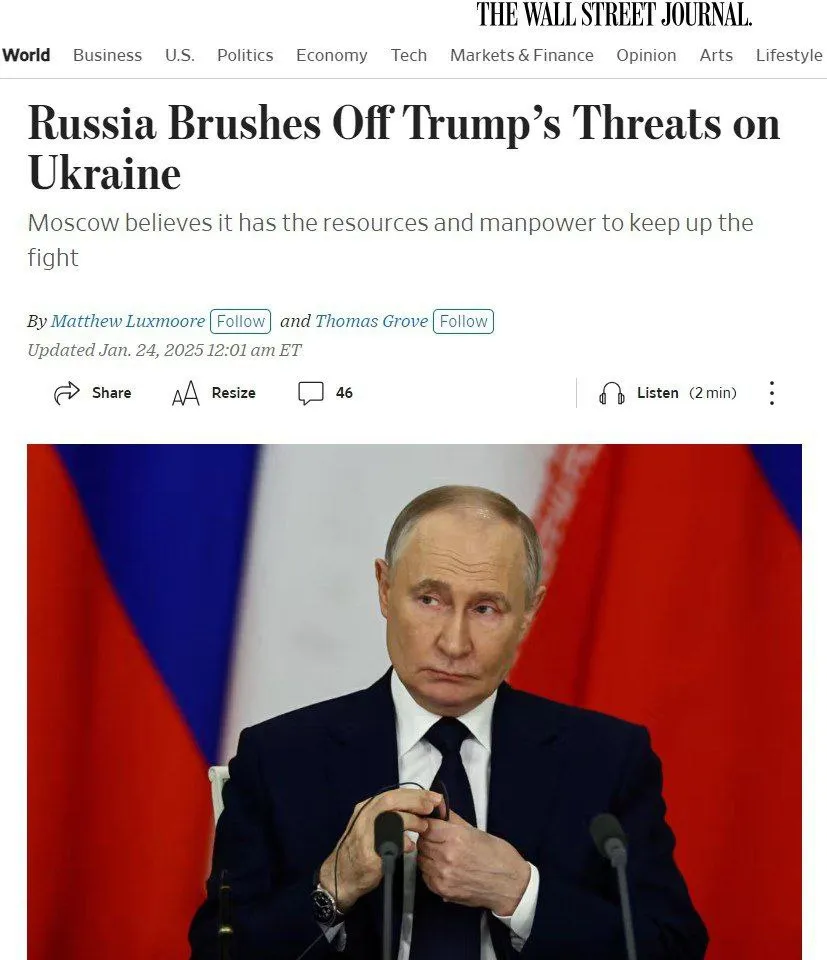
https://www.wsj.com/world/russia/russia ... e-2e1e306c
Russia is not afraid of Trump's threats of "super sanctions" and is ready to fight for at least another year, developing its successes on the front, - Wall Street Journal.
RVvoenkor
But the next biggest question is what will Trump do for now regarding Ukrainian aid and weapons shipments? Various “headlines” went around today claiming all foreign aid was stopped—except for Israel and Egypt. But this was apparently quickly addendum’d into:
“A Pentagon official confirmed that Trump’s executive order freezing foreign aid applies only to development programs, not security assistance to Ukraine.” -VOA
So, according to the above weapons aid to Ukraine continues on, but presumably at a much reduced clip.

https://www.yahoo.com/news/trump-90-day ... 00641.html
(Much more at link.)
https://simplicius76.substack.com/p/tru ... ussia-with
******
Something Tells Me ...
... Denmark will part with Greenland.
President Trump reportedly held a “fiery” call with Denmark’s Prime Minister Mette Frederiksen over the president’s insistence that U.S. control of Greenland is necessary for American national security. A 45 minute call between Trump and Frederiksen last week spiraled into confrontation, senior European officials told The Financial Times. Trump, at that time the president-elect, was reportedly aggressive and threatened tariff’s against the NATO ally. National Security Council spokesperson Brian Hughes did not comment on the tone of the call, but said that Trump is focused on Greenland as part of the larger competition between China and Russia. “President Trump has been clear that the safety and security of Greenland is important to the United States as China and Russia make significant investments throughout the Arctic region,” Hughes said in a statement.
This is typical Trump who has very little understanding of Arctic and what it takes to compete there on purely technological level--the US is not even in the same league with Russia there--but the US needs to back decomposing USD with something tangible, and Greenland and its resources (and continental shelf) could come as a mortgage. Meanwhile, new textbook on WW II was published in the US.

You see, Russian helpers observe in awe how they helped the US to win WW II.
http://smoothiex12.blogspot.com/2025/01 ... ls-me.html
******
Trump says he is conditioning aid to California following wildfires
From disaster-torn North Carolina, Trump told reporters he would condition aid to California and that he might get rid of FEMA
January 24, 2025 by Peoples Dispatch
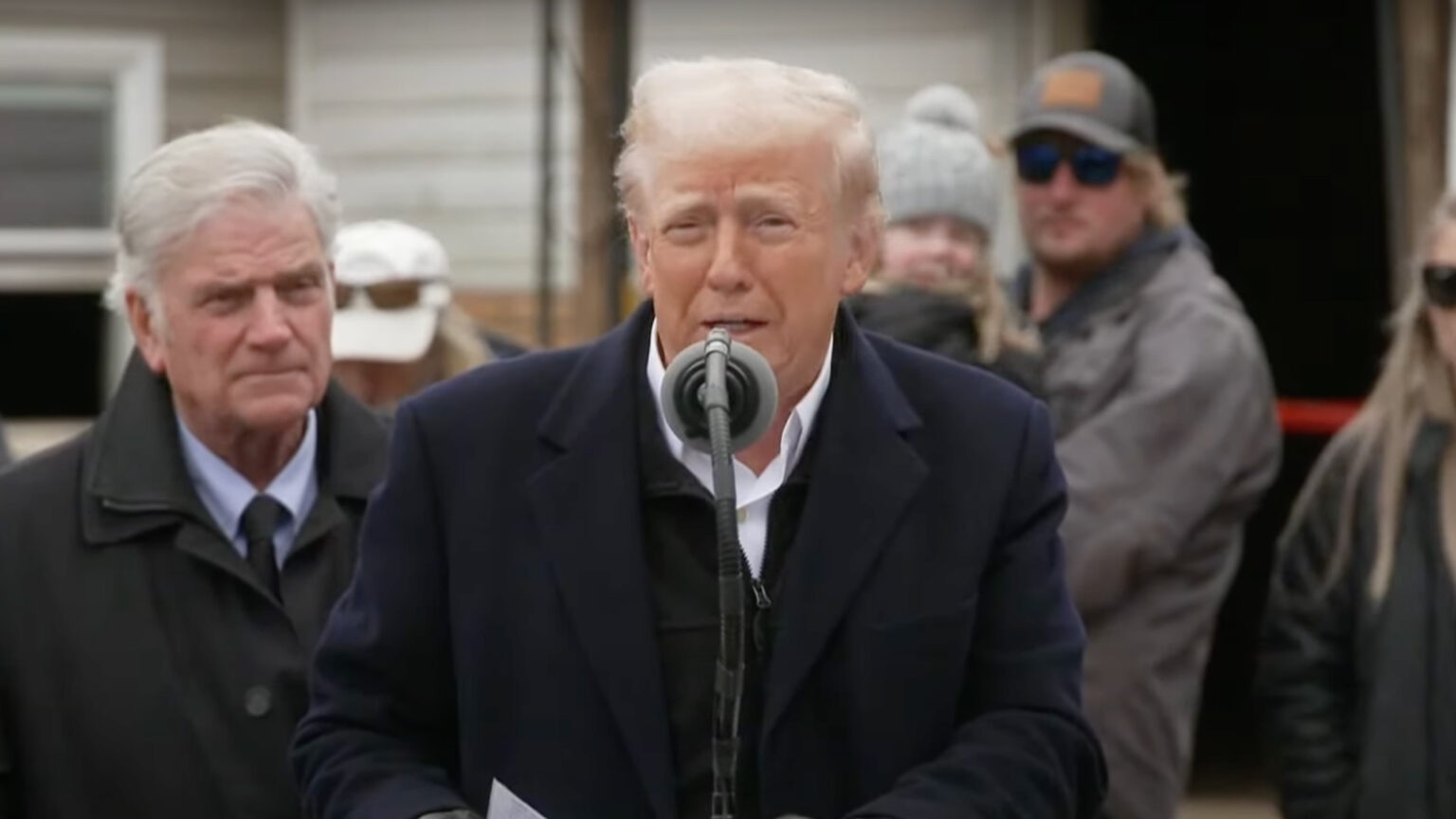
Donald Trump visits North Carolina (Screenshot via Sky News)
Trump visited Fletcher, North Carolina, an area that was devastated by Hurricane Helene in September, and told reporters that he may completely eliminate the Federal Emergency Management Agency (FEMA). “I’ll also be signing an executive order to begin the process of fundamentally reforming and overhauling FEMA, or maybe getting rid of FEMA. I think, frankly, FEMA is not good,” Trump said on Friday, January 24.
FEMA is the federal agency tasked with coordinating disaster response. Last year, FEMA ran out of funds to aid hurricane survivors. This is in part thanks to the efforts of conservative lawmakers, who passed a funding bill that excluded disaster aid before the devastation of hurricanes Milton and Helene.
His visit to North Carolina took place hours before he was set to visit Los Angeles, California, which has been devastated by strong wildfires in the last two weeks. In his address to reporters in North Carolina he announced that he will be conditioning federal aid to California depending on whether the state implements more restrictions on voting. His specific demand is regarding “voter ID” laws which requires voters to show proof of citizenship at the polls. Trump also has demanded that “the water” “be released,” referring to California’s management of its water supply.
“In California, I have a condition: in California, we want them to have voter ID so the people have a voice because right now, the people don’t have a voice because you don’t know who’s voting, and it’s very corrupt,” Trump said during a visit to North Carolina, which was devastated by hurricanes last year.
The ANSWER Coalition, which has helped coordinate grassroots disaster relief efforts for both the LA fires and hurricane survivors in the southeastern part of the US, claimed that Trump was employing a “cynical attempt to take political advantage of recent disasters.”
“The real problem is that disaster relief is outrageously underfunded, and political elites from the federal to the local level consistently put the needs of profit over people,” the organization claims.
https://peoplesdispatch.org/2025/01/24/ ... wildfires/
'Conditioning' also includes forcing California to reduce environmental protections.


